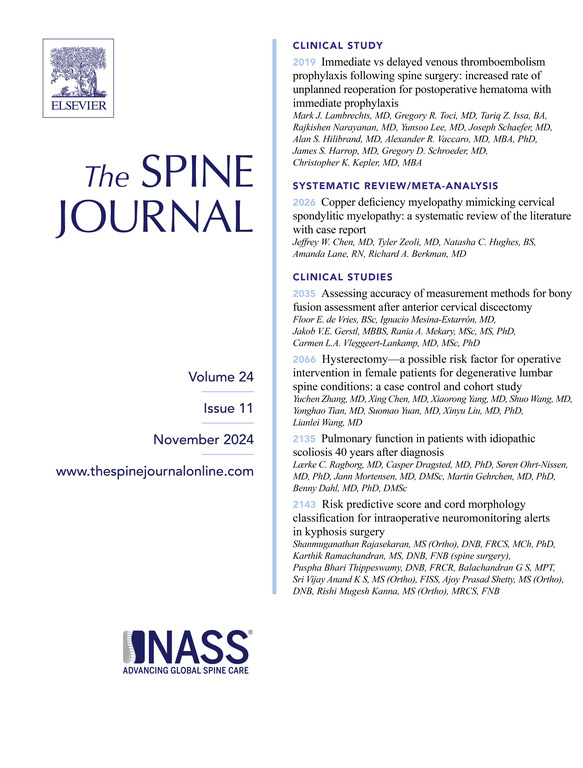用于自动诊断退行性颈椎病和磁共振成像脊髓信号改变的深度学习模型。
IF 4.9
1区 医学
Q1 CLINICAL NEUROLOGY
引用次数: 0
摘要
背景情况:针对 MRI 上退行性颈椎病的深度学习(DL)模型可以提高报告的一致性和效率,从而解决一个重要的全球健康问题。目的:创建一个 DL 模型,用于检测和分类颈髓信号异常、椎管和神经孔狭窄:患者样本:总共分析了 504 例 MRI 颈椎(504 例患者,平均年龄(58 岁)±13.7[SD];202 例女性),其中 454 例用于培训(90%),50 例(10%)用于内部测试。此外,还有 100 个核磁共振颈椎图像用于外部测试(100 名患者,平均年龄(60 岁)±13.0[标准差];26 名女性):使用 DL 模型对椎管狭窄、神经孔狭窄和脊髓信号异常进行自动检测和分类。计算召回率(%)、评分者之间的一致性(Gwet's kappa)、灵敏度和特异性:利用轴向 T2 加权梯度回波和矢状 T2 加权图像,在一位经验丰富的肌肉骨骼放射科医生(12 年经验)标注的数据上训练了基于变压器的 DL 模型。内部测试包括由两名肌肉骨骼放射科医生(参考标准,均有 12 年经验)、两名放射科亚专科医生和两名在训放射科医生共同标注的数据。进行了外部测试:结果:DL 模型在椎管的所有级别上都表现出了极大的一致性,超过了所有读者(κ=0.78,p 结论:我们的 DL 模型对 MRI 上的退行性颈椎病显示出良好的性能,与参考标准的一致性很高。该工具可帮助放射科医生在临床实践中提高核磁共振颈椎病评估的效率和一致性。本文章由计算机程序翻译,如有差异,请以英文原文为准。
Deep learning model for automated diagnosis of degenerative cervical spondylosis and altered spinal cord signal on MRI
BACKGROUND CONTEXT
A deep learning (DL) model for degenerative cervical spondylosis on MRI could enhance reporting consistency and efficiency, addressing a significant global health issue.
PURPOSE
Create a DL model to detect and classify cervical cord signal abnormalities, spinal canal and neural foraminal stenosis.
STUDY DESIGN/SETTING
Retrospective study conducted from January 2013 to July 2021, excluding cases with instrumentation.
PATIENT SAMPLE
Overall, 504 MRI cervical spines were analyzed (504 patients, mean=58 years±13.7[SD]; 202 women) with 454 for training (90%) and 50 (10%) for internal testing. In addition, 100 MRI cervical spines were available for external testing (100 patients, mean=60 years±13.0[SD];26 women).
OUTCOME MEASURES
Automated detection and classification of spinal canal stenosis, neural foraminal stenosis, and cord signal abnormality using the DL model. Recall(%), inter-rater agreement (Gwet's kappa), sensitivity, and specificity were calculated.
METHODS
Utilizing axial T2-weighted gradient echo and sagittal T2-weighted images, a transformer-based DL model was trained on data labeled by an experienced musculoskeletal radiologist (12 years of experience). Internal testing involved data labeled in consensus by 2 musculoskeletal radiologists (reference standard, both with 12-years-experience), 2 subspecialist radiologists, and 2 in-training radiologists. External testing was performed.
RESULTS
The DL model exhibited substantial agreement surpassing all readers in all classes for spinal canal (κ=0.78, p<.001 vs κ range=0.57–0.70 for readers) and neural foraminal stenosis (κ=0.80, p<.001 vs κ range=0.63–0.69 for readers) classification. The DL model's recall for cord signal abnormality (92.3%) was similar to all readers (range: 92.3–100.0%). Nearly perfect agreement was demonstrated for binary classification (grades 0/1 vs 2/3) (κ=0.95, p<.001 for spinal canal; κ=0.90, p<.001 for neural foramina). External testing showed substantial agreement using all classes (κ=0.76, p<.001 for spinal canal; κ=0.66, p<.001 for neural foramina) and high recall for cord signal abnormality (91.9%). The DL model demonstrated high sensitivities (range:83.7%–92.4%) and specificities (range:87.8%–98.3%) on both internal and external datasets for spinal canal and neural foramina classification.
CONCLUSIONS
Our DL model for degenerative cervical spondylosis on MRI showed good performance, demonstrating substantial agreement with the reference standard. This tool could assist radiologists in improving the efficiency and consistency of MRI cervical spondylosis assessments in clinical practice.
求助全文
通过发布文献求助,成功后即可免费获取论文全文。
去求助
来源期刊

Spine Journal
医学-临床神经学
CiteScore
8.20
自引率
6.70%
发文量
680
审稿时长
13.1 weeks
期刊介绍:
The Spine Journal, the official journal of the North American Spine Society, is an international and multidisciplinary journal that publishes original, peer-reviewed articles on research and treatment related to the spine and spine care, including basic science and clinical investigations. It is a condition of publication that manuscripts submitted to The Spine Journal have not been published, and will not be simultaneously submitted or published elsewhere. The Spine Journal also publishes major reviews of specific topics by acknowledged authorities, technical notes, teaching editorials, and other special features, Letters to the Editor-in-Chief are encouraged.
 求助内容:
求助内容: 应助结果提醒方式:
应助结果提醒方式:


